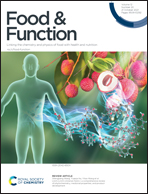Over a century since ephedrine discovery: an updated revisit to its pharmacological aspects, functionality and toxicity in comparison to its herbal extracts†
Abstract
Ephedrine, a sympathomimetic amine that exhibits several adrenaline actions, is a plant alkaloid that is a common ingredient in several cold, asthma and narcolepsy treatment preparations, and in obesity management and sport medicine. Its principal action mechanism relies on its direct adrenergic actions as well as indirect role that involves the release of epinephrine and norepinephrine, thus increasing the activity of epinephrine and norepinephrine at the postsynaptic α and β receptors. Nevertheless, its serious side effects, including stroke, heart attack, drug abuse and interactions, have never been comprehensively reviewed. We conducted a systematic review of data on ephedrine, including its occurrence in functional foods, pharmacological aspects, metabolism, pharmaco/toxicokinetics and clinical features. Furthermore, a review of ephedrine natural structural analogues with regards to their differential adrenergic receptor binding affinities, food interaction, and their impact on the pharmacokinetics and effects relative to ephedrine are presented for the first time, and in comparison to its action when present in herbs.



 Please wait while we load your content...
Please wait while we load your content...